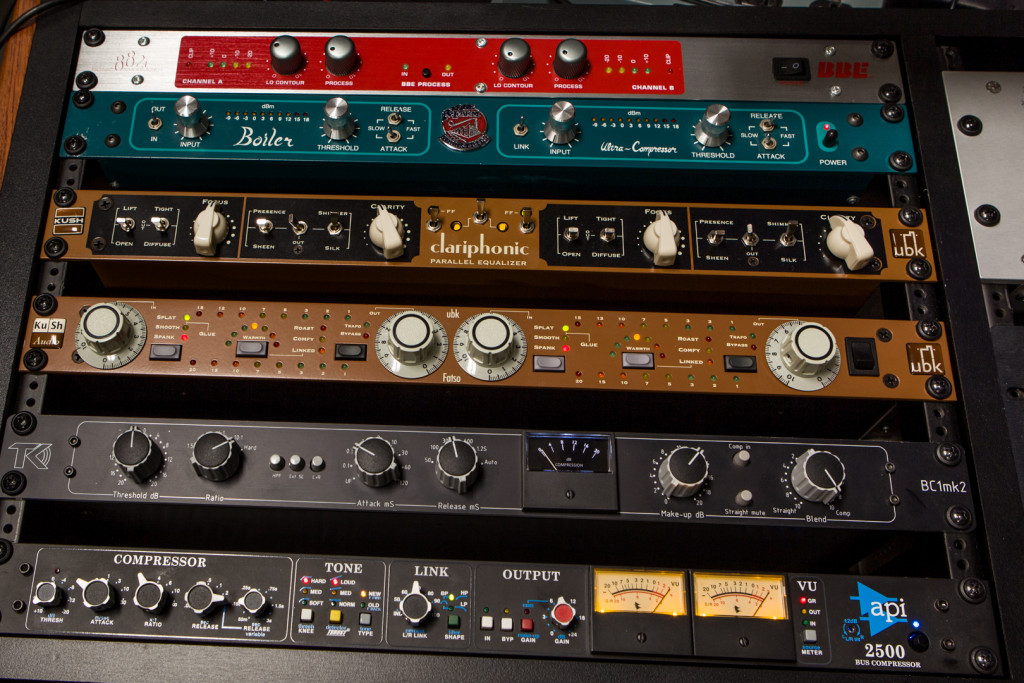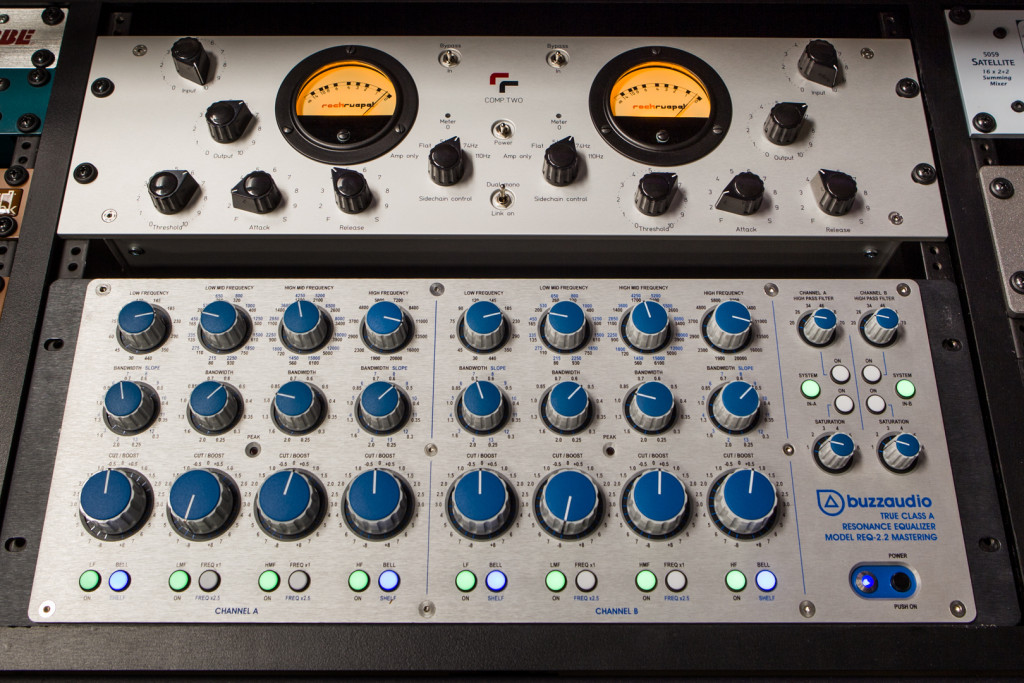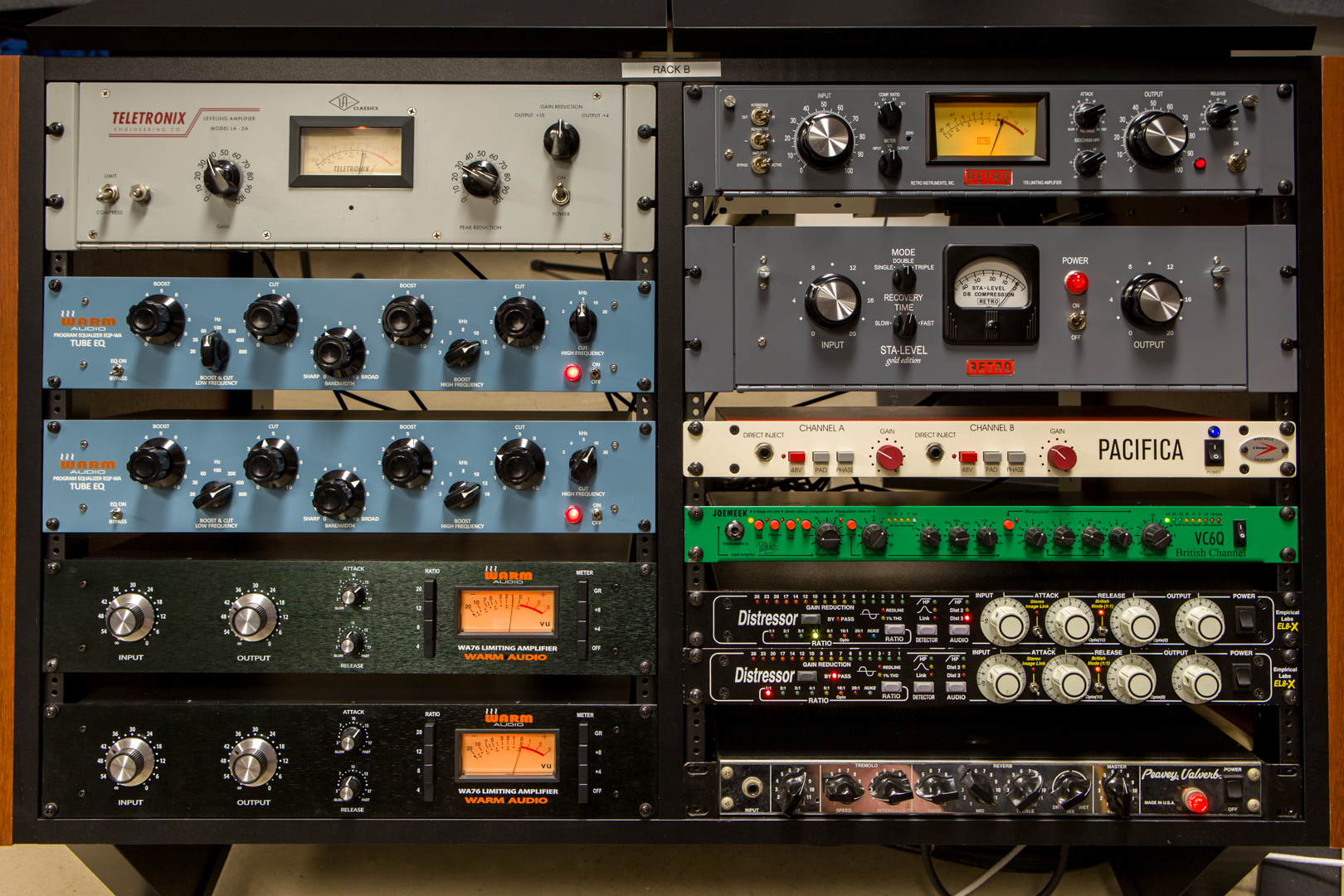Glyph was built from the ground up as a true hybrid analog/digital studio. 24 channels of DAW faders provide a hands-on experience without the compromises of having a large-format console where, in a modern studio, the DAW should really be. Two ultrawide monitors provide a complete meter bridge for all 48 input and output channels, a 1/3 octave spectrum analyzer, goniometer, level meters, and plenty of room for plugins and synths.
Instead of channel strips, all of the most critical bus processing is located right in front of you as you sit at the desk, making it easy to dial in exactly the sound you want. No need to lean over backwards to try and get one ear in the sweet spot as you adjust a 2-bus EQ or compressor in a rack on the other side of the room. Preamps and additional outboard gear is located in 3 wing racks to the side of the desk, in easy reach.

The left side of the desk contains most of the stereo bus compressors and mastering chain. UBK/Empirical Labs Fatso, TK BC-1mk2 (SSL G bus compressor clone) and API 2500 compressors all work great on drum bus and 2-bus. The Ridge Farm Boiler ultra-compressor does amazing things to drum overheads and room mics. The UBK Clariphonic and BBE Sonic Maximizer let you put some final polish on your track.

The center of the desk has two large pieces. The Rockruepel Comp.Two is a fantastic all-tube compressor which can do everything from sweet mastering compression with a bit of tube warmth to a full-on crushed room mic sound on the edge of Fairchild territory. The Buzz REQ-2.2 Mastering Edition is an utterly transparent mastering EQ with fully stepped controls that provide perfect matching between channels with zero phase difference. Each EQ band is build from a passive circuit of parallel inductors and chokes tunable to 72 different frequency ranges followed by a differential class-A amplifier. It also has a subtle saturation circuit which can be engaged and set to one of five different levels.

The right side of the desk has the Rupert Neve Designs 16-channel analog summing mixer. In addition to providing out-of-the-box summing with transformers on every channel, this box has two RND Silk circuits which provide adjustable output transformer saturation in two bands (lows and mids/highs). The Elysia mpressor is another stereo compressor with some incredibly unique features such as anti-log compression curves and negative ratios that allow it to do anything from mastering to extreme, pumping parallel drum bus compression. Below this, 16 channels of Tonelux EQ give you hands-on access to fully discrete parametric EQs. These were designed by Paul Wolff, and in many ways are the continuation of his work at API. Like API 550s, the proportional Q feature automatically adjusts the Q of each band to be more selective as you add increase or decrease the level. Unlike APIs, they can also be set to a fixed 1/3 octave width.
Rack A. At the top is the Vertigo VSM-2 Mix Satellite. It’s a mini mastering mixer, which allows you to switch and mix in two external processors in left/right or mid/side, and it also has two distortion modules which can generate anything from a slight fattening or shimmer to self-resonant, howling destruction. Next to it are 8 channels of the dynamics modules from the SSL 9000 series console. Your drums will love them. This rack also contains most of the preamps, including the Thermionic Culture Rooster, 8 channels of Tonelux pres, 8 channels of Focusrite ISA pres, and an 8-channel True Precision preamp. Our always-up-to-date, fully labeled patch field is in the bottom right. It’s normalled so that you can start tracking and mixing without having to patch anything, although you can of course reconfigure anything.


Rack B. This contains most of the mono compressors, including an LA-2A, two 1176s, a Retro 176, a Retro Sta-Level, and the mandatory pair of distressors. There are also two channels of Pultec EQ, two A Designs Pacifica preamps, a JoeMeek channel strip, and a funky Peavey tube-driven spring reverb.
Rack C. At the top is a Tascam stereo spring reverb. Below that is Mercury M72s, which provides two channels of much-beloved all-tube Telefunken V72s microphone preamps (the epitome of “warm” preamp sound), updated to have a modern DI circuit and the ability to run line-level signals through them as a bus processor. After that are two Chandler Germanium pres, which provide an incredibly unique sound. Next, an additional 8 channels of Audient pres are mostly used for listen/talkback mics but can be patched in anywhere. At the bottom of the left side are 48 input and 48 output channels of SSL AlphaLink conversion. The right side of Rack C contains the DAW and 6-channel headphone amplifier.

